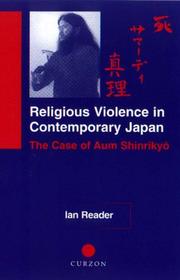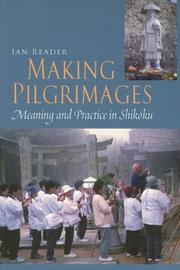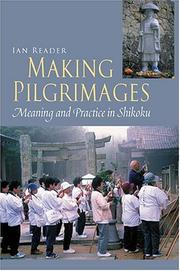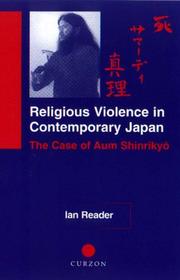| Listing 1 - 10 of 30 | << page >> |
Sort by
|

ISBN: 0700711090 Year: 2000 Publisher: Richmond : Curzon,
Abstract | Keywords | Export | Availability | Bookmark
 Loading...
Loading...Choose an application
- Reference Manager
- EndNote
- RefWorks (Direct export to RefWorks)

ISBN: 0824829077 9780824829070 Year: 2006 Publisher: Honolulu : University of Hawai'i Press,
Abstract | Keywords | Export | Availability | Bookmark
 Loading...
Loading...Choose an application
- Reference Manager
- EndNote
- RefWorks (Direct export to RefWorks)
This study involves a fourteen-hundred-kilometer-long pilgrimage around Japan's fourth largest island, Shikoku. In traveling the circuit of the eighty-eight Buddhist temples that make up the route, pilgrims make their journey together with Kobo Daishi (774-835), the holy miracle-working figure who is at the heart of the pilgrimage. Once seen as a marginal practice, recent media portrayal of the pilgrimage as a symbol of Japanese cultural heritage has greatly increased the number of participants, both Japanese and foreign. In this absorbing look at the nature of the pilgrimage, Ian Reader examines contemporary practices and beliefs in the context of historical development, taking into account theoretical considerations of pilgrimage as a mode of activity and revealing how pilgrimages such as Shikoku may change in nature over the centuries. This rich ethnographic work covers a wide range of pilgrimage activity and behavior, drawing on accounts of pilgrims traveling by traditional means on foot as well as those taking advantage of the new package bus tours, and exploring the pilgrimage's role in the everyday lives of participants and the people of Shikoku alike. It discusses the various ways in which the pilgrimage is made and the forces that have shaped it in the past and in the present, including history and legend, the island's landscape and residents, the narratives and actions of the pilgrims and the priests who run the temples, regional authorities, and commercial tour operators and bus companies. In studying the Shikoku pilgrimage from anthropological, historical, and sociological perspectives, Reader shows in vivid detail the ambivalence and complexity of pilgrimage as a phenomenon that is simultaneously local, national, and international and both marginal and integral to the lives of its participants. Critically astute yet highly accessible, Making Pilgrimages will be welcomed by those with an interest in anthropology, religious studies, and Japanese studies, and will be essential for anyone contemplating making the pilgrimage themselves. -- Back cover.

ISBN: 1860340032 Year: 2001 Publisher: Folkestone Global Books Ltd.
Abstract | Keywords | Export | Availability | Bookmark
 Loading...
Loading...Choose an application
- Reference Manager
- EndNote
- RefWorks (Direct export to RefWorks)
Book
ISBN: 9781138647763 9780415709194 Year: 2014 Publisher: New York, NY : Routledge, Taylor & Francis Group,
Abstract | Keywords | Export | Availability | Bookmark
 Loading...
Loading...Choose an application
- Reference Manager
- EndNote
- RefWorks (Direct export to RefWorks)
Pilgrims and pilgrimages --- Tourism --- Religious aspects --- Japan --- Religious life and customs.
Book
ISBN: 9780198718222 0198718225 Year: 2015 Publisher: Oxford Oxford University Press
Abstract | Keywords | Export | Availability | Bookmark
 Loading...
Loading...Choose an application
- Reference Manager
- EndNote
- RefWorks (Direct export to RefWorks)
Pilgrimage is found in most religious cultures, from Saudi Arabia, Mexico, and India, to France, Spain, and Japan. In this volume, Ian Reader explores the key themes of pilgrimage throughout the ages, considering its various forms and its identity as a 'spiritual tourism' industry, to explain why it has remained so popular in an increasingly secular age

ISBN: 0824828763 Year: 2005 Publisher: Honolulu University of Hawaii press
Abstract | Keywords | Export | Availability | Bookmark
 Loading...
Loading...Choose an application
- Reference Manager
- EndNote
- RefWorks (Direct export to RefWorks)

ISBN: 0700711082 Year: 2000 Publisher: Richmond Curzon
Abstract | Keywords | Export | Availability | Bookmark
 Loading...
Loading...Choose an application
- Reference Manager
- EndNote
- RefWorks (Direct export to RefWorks)

ISBN: 0333523229 Year: 1991 Publisher: London Macmillan
Abstract | Keywords | Export | Availability | Bookmark
 Loading...
Loading...Choose an application
- Reference Manager
- EndNote
- RefWorks (Direct export to RefWorks)
Book
ISBN: 9780824844059 Year: 2023 Publisher: Honolulu
Abstract | Keywords | Export | Availability | Bookmark
 Loading...
Loading...Choose an application
- Reference Manager
- EndNote
- RefWorks (Direct export to RefWorks)
Book
ISBN: 9781350086517 1350086517 1350170143 1350086525 Year: 2019 Publisher: London Bloomsbury
Abstract | Keywords | Export | Availability | Bookmark
 Loading...
Loading...Choose an application
- Reference Manager
- EndNote
- RefWorks (Direct export to RefWorks)
"This book examines the trajectory and development of the Japanese religious movement, Agonshu, commonly portrayed in Japan as a 'new religion', and its charismatic founder Kiriyama Seiyu. Based on field research spanning 30 years it examines Agonshu from when it first captured attention in the 1980s with its spectacular rituals and use of media technologies, through a period of stagnation, until its response to the 2016 death of its founder. Via an in-depth profile of Agonshu and the pivotal role of Kiriyama Seiyu as founder, the authors examine and critique the concept of 'new religions', and discuss the nature and significance of charisma, charismatic leadership and religious entrepreneurship. The book discusses the 'democratisation' of practice and the demands made by movements such as Agonshu on members, while examining how a movement that developed in Japan has expressed seemingly universal concepts while becoming increasingly focused on revisionist nationalism and issues of Japanese identity. In examining the dilemma religions commonly face on the deaths of charismatic founders, Baffelli and Reader look at Agonshu's response to Kiriyama's death, how and why it has transformed a human founder into a figure of worship, and how, through such founder veneration, it has become increasingly normative in Japanese contexts. By examining Agonshu in the wider context, the authors draw attention to the importance of understanding the trajectories of 'new' religions and how they can become 'old' even within their first generation"--
J1960 --- Japan: Religion -- new religions --- Buddhism --- Religion. --- Doctrines --- Doctrines. --- Kiriyama, Seiyū, --- Agonshū. --- Japan --- Japan. --- Kiriyama, Seiyū, --- Agonshū. --- Buddha and Buddhism --- Lamaism --- Ris-med (Lamaism) --- Religions --- Tsutsumi, Masuo, --- 桐山靖雄, --- 堤真寿雄, --- 阿含宗
| Listing 1 - 10 of 30 | << page >> |
Sort by
|

 Search
Search Feedback
Feedback About UniCat
About UniCat  Help
Help News
News